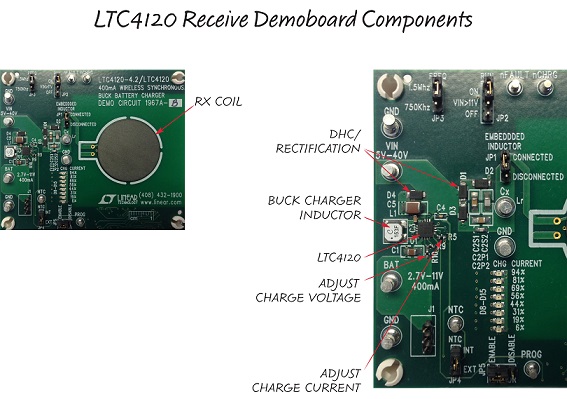Due to the high efficiency buck switching topology of the LTC4120 charger as well as the DHC technology, overall system efficiency is about 50 – 55%. To calculate this value, divide the battery charge power by the DC input power to the transmitter. Overall efficiency is very dependent on coupling and load. When charging a single-cell Li-Ion battery at 400mA, the components on the LTC4120-based receiver board stay within 10ºC of ambient temperature. The LTC4120-based receiver can be seen in Figure 3.

Other System Considerations
The LTC4120-based wireless charging system can charge a battery at 400mA across an impressive gap. Lithium-based rechargeable batteries power many handheld applications and both 1S (nominally 3.7V) and 2S (nominally 7.4V) Li-Ion packs are common. Extended cycle life and improved safety features are creating significant market space of LiFePO4 batteries as well. Furthermore, there is a wide variety of target charge voltages within these battery packs as customers fine-tune the tradeoffs between initial battery capacity, cycle life and retained capacity over time. To accommodate this variety, the LTC4120 does not need any additional circuitry to charge 1- and 2-cell Li-Ion batteries as well as 1-, 2- and 3-cell LiFePO4 batteries. Charge current can be programmed from 50mA to 400mA while charge voltage can be programmed from 3.5V to 11V.
In addition to a built-in constant-current / constant-voltage charge algorithm, the LTC4120 includes multiple battery safety features. A termination timer safely ends a charge cycle. While an NTC input provides battery temperature monitoring and automatically suspends charging during unsafe temperature conditions. Two charge status pins provide charge cycle and fault status information.
Conclusion
Wireless charging can add value, reliability and robustness in many different types of applications. It is important to consider how much power is required in the application as well as how far that power must be transmitted and with what kind of alignment tolerance. Determining how to deal with the worst-case condition of maximum load power with minimum coupling between the transmitter and receiver is often the easy part. Managing additional available power during low load or no load conditions with maximum coupling can be challenging. To help address this challenge, Linear Technology has developed the LTC4120, a new IC that provides everything required to make a compact and highly efficient wireless power battery charger. Its DHC technology enables a very wide transmit distance as well as superb transmit to receive coil alignment insensitivity. LTC4120 is a key component in a robust contactless charging system.





